-
 511 Hits
511 Hits
-
 79.78% Score
79.78% Score
-
 11 Votes
11 Votes
|
|
Mountain/Rock |
|---|---|
|
|
39.71804°N / 21.61711°E |
|
|
Thessaly |
|
|
Trad Climbing |
|
|
Spring, Fall |
|
|
1476 ft / 450 m |
|
|
Overview
Holy Ghost Guardian/Heiliggeistwächter
Meteora (Μετέωρα) is not a name of a single rock formation, actually it's an area, a charming and suggestive climbing site located in the Thessaly region of Greece, including about 170 summits of various shapes and types, as rocky pinnacles, spires, some of which are truly amazing and bizarre, minor peaks and also a few massive mountains. The towers overlook the village of Kastràki and the town of Kalambàka and feature about 850 multi-pitch and single pitch routes. The towers of Meteora are quite famous all over the world, due to their singularity and a bit of mistery surrounding the place. The whole region is divided into several groups with more than 670 climbing routes.
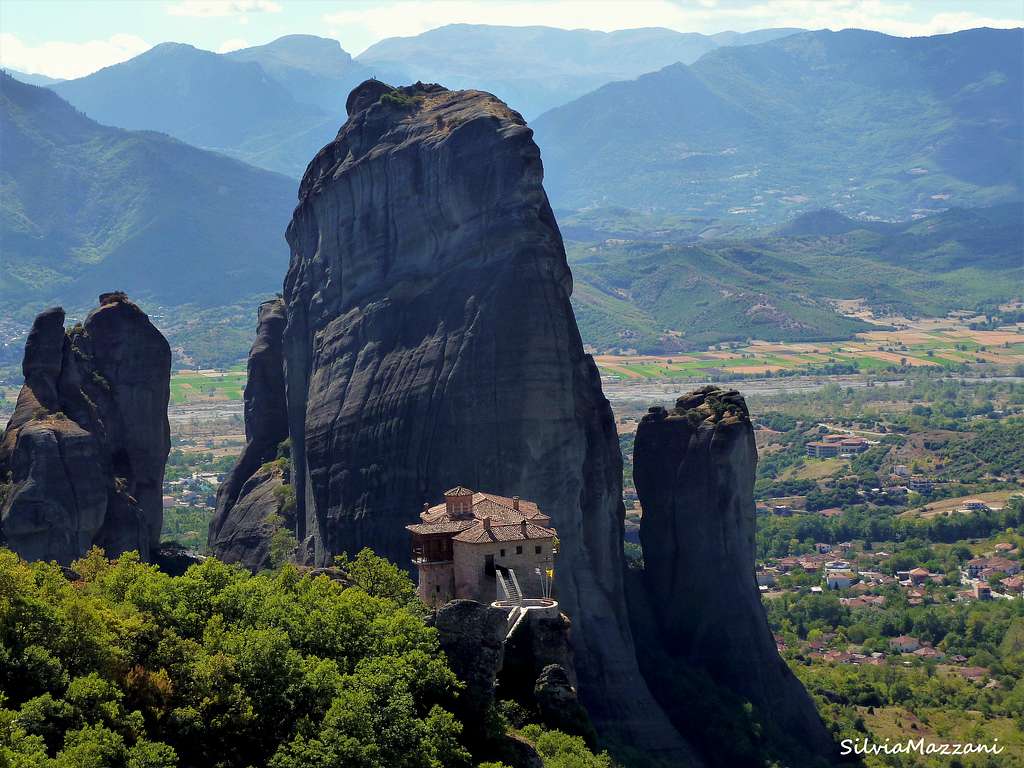
The Holy Ghost Guardian/Heiliggeistwächter is a tower located West of the massive Holy Ghost, closely next to it, like a minor spire resting on the wall of Holy Ghost. As its name suggests it looks like a watchtower to the taller and more massive structure.
Shade: until 13:00. Exposure: SW

Getting There
Meteora is situated in the Thessaly region of Greece, Northern half of Greece, approximately 25 km NNW from Trikala, and immediately North of Kalambaka and Kastraki, the two main small towns in the area, both located very close to the rocks. The closest main town is Larissa. The distance to Kalambaka is about 360 km from Athens and 237 km. from Thessaloníki.
By plane - Meteora can be approached from Athens Eleftherios Venizelos airport or from Thessaloniki airport. From these airports you can:
- take a domestic flight to Larissa (about 85 km from Kalambaka) - rent a car, useful once you are in Kastraki, but not essential, then 4 hour drive to Kalambaka on a new highway. - use public transports (bus or train). Getting to Meteora without a car is easy thanks to the train from Athens that stops in Kalambaka.
By ferry from Italy – If you wish to travel with your own car, there are different shipping companies and many ferries departures to Igoumenitza from the harbours of Ancona, Bari and Brindisi across the Adriatic.Then a mountain road to the small town of Kalambaka at the foot of the wonderful Meteora.
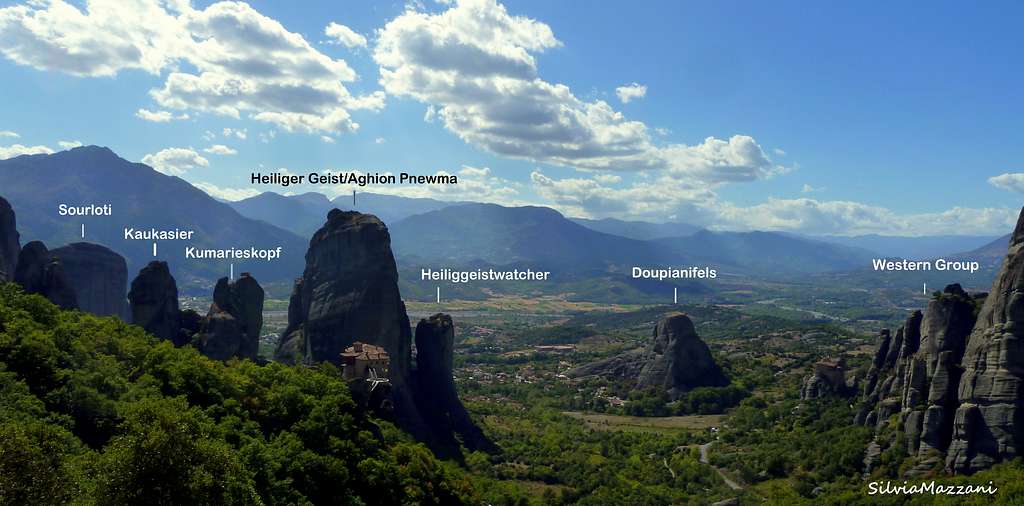
Walking approach
A. from the road leading to the upper Meteora monasteries
B. approaching by walk starting from Kastraki old sector
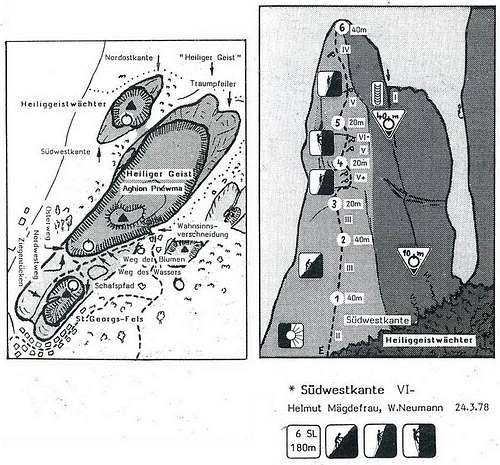
A. When driving from the village of Kastraki towards North-East to reach the summit monasteries you soon see the rounded peak of the Doupianifels on the left near the road and just in front on the right the Holy Ghost (recognizable for the niches with flags in the middle of its wide wall) and Heiliggeistwachter (a minor spire resting on the wall of Aghion Pnéwma). After a bend towards right, the road passes a pull-out on the left. Continue driving and reach a little pull-out just in front of the obvious mighty structure of Aghion Pnéwma. Park the car and take a path descending to the bottom of the valley, then crossing the path coming from the village. Take the right to get the routes 1-2-3 and the left one to get the routes from 8 to 15.
B. Reach the Church of Kastraki in the old part of the village. Proceed down the street towards the southwest edge of Aghion Pnéwma, continue straight down and park near a small building on your right. The trail starts behind it.
Routes
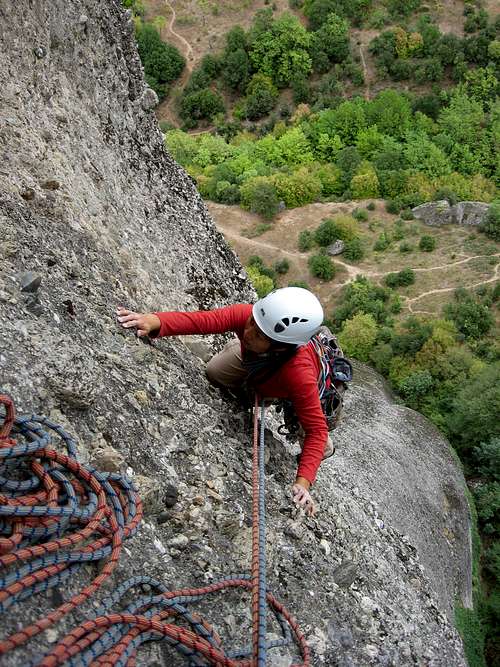
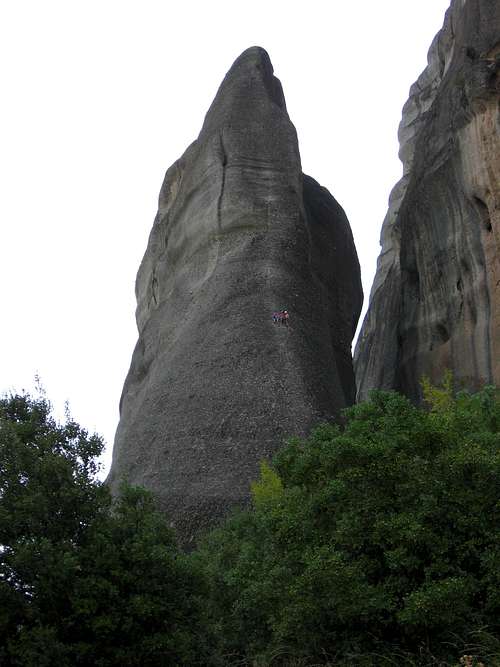
- South-West ridge 6a, 180 m, 6 pitches First ascent: H. Magdefrau, W. Neumann The classic route of the spire. See here the route report: Sudwestkante Heiliggeistwachter The SW ridge has two variants:
- Moderner Einstieg zur SW kante V+, 65 m, 2 pitches First ascent: Tiannis Kinatidis, C. Karapiperis 3.4.1994 - It's a starting variant on the West side
- Logische Variante zur SW kante V+, 15 m First ascent: D. Hasse, W. Eckert, Ursula Hasse 15.9.1992 - It's a short variant on the left of the fourth pitch
- North-West ridge V+, 145 m, 4 pitches First ascent: D. Hasse, H.L. Stutte 15.8.76 See here the route report:
- Alptraum VII-, 90 m, 3 pitches First ascent: Uwe Rossler, Hagen Koban 23.9.1992
- Black Magic 6a+, 50 m, 4 pitches First ascent: A. Mitronatsios, D. Hasse 1990 A sport style route on the shade
Descent: abseiling down the East side. From the summit follow the path in the direction of Holy Ghost, descending to a ledge with trees. A deep groove leads to the first anchor. A 6 meters almost horizontal rappel reachs the second anchor. From here 1 x 55 m. abseil (or 1 x 45 m. and 1 x 10 m.).
Red Tape
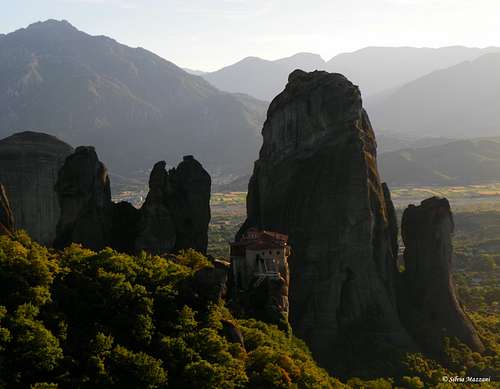
No fees and no permits required. Anyhow, if you are visiting this area, remember not to climb on rock formations with inhabited monasteries. In the Seventies Dietrich Hasse and his team decided, in agreement with local authorities, not to climb any route on these latter rock formations. This rule applies even today. Please preserve all other historical remains. Another important suggestion is not to add fixed protections on the classic routes to the pre-existing ones. If you plan to visit the monasteries, keep in mind to be appropriately dressed: men cannot wear shorts, while women must wear long skirts and not trousers, arms must be covered. Since the year 1988 Meteora was declared a Meteora Unesco World Heritage Site .
When to Climb
Spring and Autumn are the best seasons for Meteora. Avoid Summer, especially really hot days. Eiertanz is a good choice for winter mornings, in fact it's East facing in general, but the last pitch looks North. The route has sun until noon (more or less, depending on the season).
Accomodation
There is a great number of hotel rooms, B&Bs and rooms to rent in the village of Kastraki, the village built in the shadow of the Meteora towers. The nearby small town of Kalabaka also features many accomodation choices. There are also three organized campsites, amongst which the nearest one to the crags is the Camping Vrachos in Kastraki. There is also a smaller campsite near the tower of Doupiani. There are plenty of eating out options, particularly tasty traditional Greek food and pizzerias, both in Kastraki and Kalambaka.
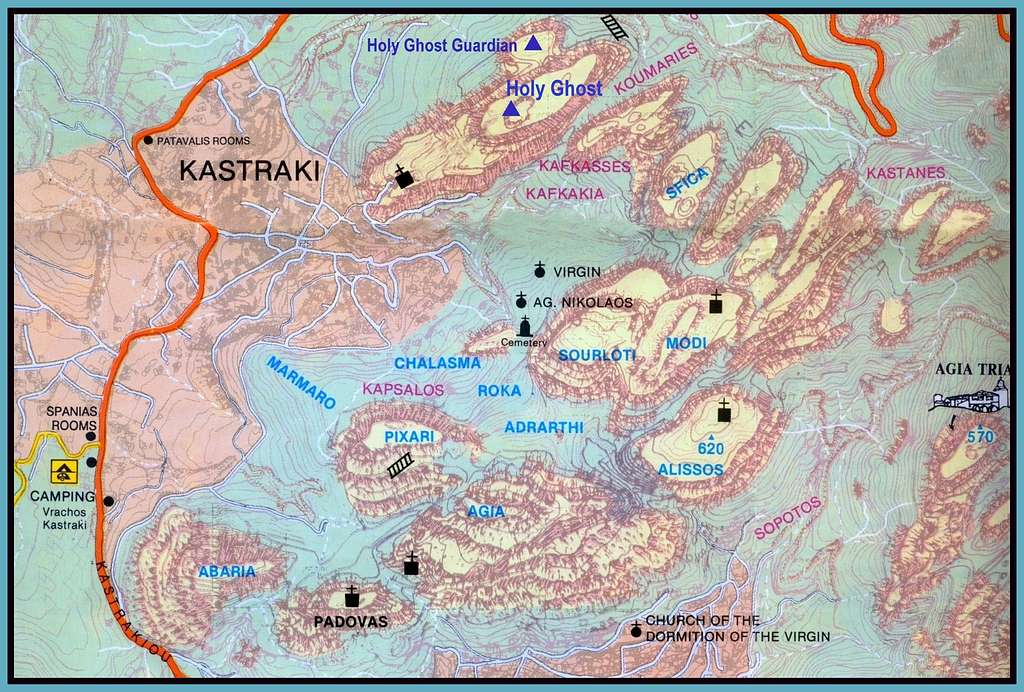
Meteo
Guidebooks and maps

“Meteora – Climbing and hiking” by Dietrich Hasse and Heinz Lothar Stutte - I edition 1986, in English and German. It contains around 230 routes. Also, it provides general information about mountaineering, hiking in Meteora, maps, directions.
The second guidebook is:

“Meteora Climbing Part II” by the same Heinz Lothar Stutte and Dietrich Hasse – II edition 2000 – German, Greek and English - Note: the II edition is not a complete guidebook, but an update to the I edition
The Meteora guidebooks can be purchased in Kastraki, Taverna Paradisos or Camping Vrachos. There is also a useful map by the same authors that can be purchased in local shops in Kastraki.

A new guidebook was recently published (2022) by the local climber Vangelis Bastios
Meteora – Sport Climbing Guide by Vangelis Bastios, Edition 2022 - The guidebook includes routes from Meteora, Theopetra, Sarakina and Agia Paraskevi.
Says Vangelis: “Because sport climbing has become increasingly popular in recent years, it helped me decide to create a guidebook for just the sport routes in Meteora and Theopetra (a cliff only 10 km outside Meteora, with good quality limestone).
External links
Climbing web-sites:
- Climbgreece
- Climb-Europe Greece/Meteora
- Meteora-rock-climbing
The site of Jörg Brutscher, one of the German climbers, who first climbed many hard cracks in Meteora. Unfortunatelly his site is only in german.
Also by Jörg Brutscher, check : www.sandsteinklettern.de. In german only, but with a lot of information. Click on Wegedatenbank, then Griechenland. There are a lot of routes and very good drawings/maps of the various rock groups. Some very interesting climbing photos from Meteora, Elb and other places.
The site www.routes.gr is the best database of mountain climbing routes in Greece. Unfortunatelly has only a few, mainly new, routes from Meteora in this link: www.routes.gr/?Lang=en&Page=Climbing/Trad/Areas/Meteora
Other info here:
The site of Kalambaka town: www.kalampaka.com
The site of the Hellenic Mountain Guide Association

